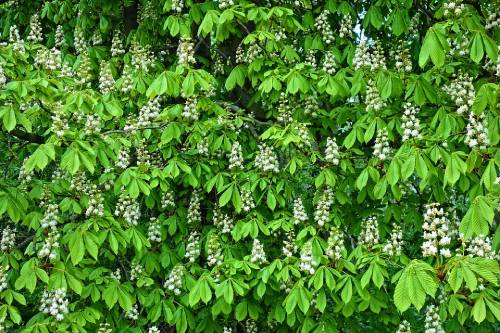Horse chestnut identification and control
About this weed
Horse chestnut is designated as a weed of concern in King County. This means control is not required, but is recommended, and new plantings are discouraged.
Horse chestnut is known as Aesculus hippocastanum and it is in the horse chestnut family. Other common names are European horsechestnut, buckeye, and conker tree.

Why it’s a problem
Horse chestnut is an ornamental tree that has grown beyond gardens and parks into forests. It competes with native plants and alters natural habitat. The fruits are toxic to people and are often spread by squirrels and other animals who carry them into green spaces. It is a host for Sooty Bark Disease (Cryptostroma corticale) that can transfer to our native maple trees.
Plant description
Horse chestnut is a deciduous (plant that loses its leaves annually) tree originally from Europe. It regularly grows 50 to 80 feet in height with a round crown.
Its large leaves are arranged in a five-leaflet circle and grow in an opposite pattern on each branch (new growth is nose-to-nose instead of alternating along trunk/stem). Upright cone shaped clusters of white flowers with yellow and red spots grow in the spring. Individual flowers are small and have five white petals.
Fruits start as bright green spiky balls that brown and fall off. The single large seed (nut) within the fleshy shell is shiny reddish-brown and resembles a common chestnut.
It spreads primarily by seed, but it is possible to grow from cuttings.
When in doubt, take photos and report them on iNaturalist.
Horse chestnuts contain a toxin called saponin aesculin. This is in all parts of the tree but especially in the seeds. It generally produces mild to moderate symptoms but there are reports of more severe reactions. The most common symptom is stomach irritation. However, there are reports of more serious symptoms in children who have eaten horse chestnuts.








What to do if you find it
Because horse chestnut is already naturalized in many places in King County and is not on the State Noxious Weed List, we are not tracking locations. It is important to stress that horse chestnut is produced and sold in Washington and there are no regulations or limits on its sale or use in landscaping.
Consult an arborist if attempting to control a larger tree to ensure safety of surrounding people and property.
Control methods
We recommend using a combination of methods to control weeds. In areas with few weeds, it is important to act quickly before they become harder to control. Make a long-term plan as it often takes several years to get rid of most weeds. Start in the least infested areas first and then move into more heavily infested areas.
Manual control
Small and medium sized horse chestnut plants can be dug out when soil is damp and easier to work with. Try to remove all of the root system to avoid suckers sprouting from the disturbed root stock.
Chemical control
Stay safe when using herbicide:
- Always read the label before use.
- Wear a long-sleeved shirt, long pants, shoes, and eye protection.
- Follow state and local regulations.
See the PNW Pest Management Handbook for the most up to date and specific method for chemical control of horse chestnut (note: link is for tree-of-heaven as its methods align with that of horse chestnut).
General herbicide notes: foliar application of herbicide works well on small plants. Cut and treat applications work well for plants of all sizes. Lancing tools (EZ-ject) work well for controlling larger trees.
For more information or a site-specific recommendation in King County, contact the noxious weed program. For information in other locations, contact your local weed board or extension office.
Disposal instructions
Horse chestnut roots and shoot tips may continue to grow if they contact the ground. Pile branches and roots on tarps, downed logs, brush piles, or other elevated surfaces so plant material will dry out.
Branches can also be burned or taken to a yard waste composting facility. Seedheads should be disposed of in the garbage.
Noxious Weed Disposal - Washington State Noxious Weed Control Board

 Translate
Translate